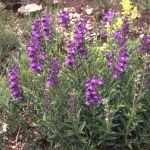| Common Name: |
Baikal Skullcap |
| Botanical Name: |
Scutellaria baicalensis |
| Genus: |
Scutellaria |
| Family: |
Lamiaceae |
| Native Location: |
Mongolia, China, and Japan. |
| Cultivation: |
Light, well-drained soil in sun or partial shade. Scutellaria lateriflora enjoys damp conditions. Scutellaria baicalensis needs sharp drainage and tolerates drought. Cut back to within 7-10cm (3-4in) of the base in early spring and pinch out in spring to encourage bushy growth. |
| Propagation: |
By seed sown in autumn; by division in autumn or spring; by basal ans semi-ripe cuttings in spring or summer. |
| Harvest: |
Roots (S. baicalensis) are lifted in autumn or spring frm plants 3-4 years old, and dried for decoctions. Plants (S. lateriflora) are cut when flowering for use in infusions, liquid extracts, and tinctures, or dried for tablets. |
| Height: |
30-38cm (12-15in) |
| Width: |
20-30cm (8-12in) |
| Hardiness: |
Z4-8 |
| Parts Used: |
Roots (huang qin) |
| Properties: |
A bitter, sedative, cooling herb that lowers fever, blood pressure, and cholesterol levels, relaxes spasms, stimulates the liver, improves digestion, controls bleeding, and has diuretic, anti-bacterial, and anti-toxic effects. It reputedly calms the fetus in pregnant women. |
| Medicinal Uses: |
Internally for enteritis, dysentery, diarrhea, jaundice, chronic hepatitis, urinary tract infections, hypertension, threatened miscarriage, nosebleed, and hemorrhage from lungs or bowel. It is an ingredient of the Chinese drug san huang zhe she ye ("injection of three yellow herbs"), the others being Coptis chinensis (See, Mishmi Bitter) and Phellodendron amurense (See, Amur Cork Tree). |
| Bibliography: |
Encyclopedia of Herbs by Deni Brown Copyright © 1995, 2001 Dorling Kindersley Limited Pp 364-365 |

